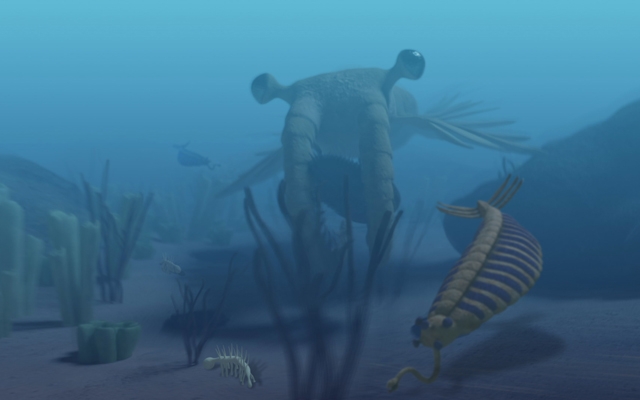
奇妙なバージェス動物群
strange Burgess Shale fauna
カンブリア爆発
現在の地球には多様な動物群が生息しているが、それらの祖先はいつ頃に出現したのであろうか。最新の分子遺伝学研究によると、既に先カンブリア時代の末(カンブリア紀よりも3億年ほど前)には現在の動物群につながる生物の多様化が始まっていた可能性が示唆される。しかし、その頃の生物は骨や殻などの硬い組織を持っていなかったために地層に化石がほとんど残されおらず、検証が難しい。
化石による証拠が充実するのは次の時代の古生代・カンブリア紀になってからである。それによると、カンブリア紀の始まりと共に硬い組織を持った動物群が爆発的に増えて多様化し、現存する動物の門(門とは、生物を分類するための階級の1つ)の全てが確認できるようになった。このイベントは「カンブリア爆発」と呼ばれている。
カンブリア爆発の証拠はカナダ・ブリティッシュコロンビア州から発見されたバージェス頁岩動物群(図)や、中国・雲南省の昆明から発見されたチェンジャン動物群に見ることができる。それらには現在に通じる動物が含まれる一方で、アノマロカリスやオパビニアに代表されるような現存する動物には見られない非常に変わった容姿を持つものが多く含まれる。それらの奇怪な動物の大半はカンブリア紀の末までに絶滅してしまったようである。
では、なぜカンブリア紀に動物が多様化したのだろうか? カンブリア紀がそれ以前の時代と違うのは、アノマロカリスのような餌を捕らえて食べる大型の動物が出現したことである。そのような捕食動物が出現すると食べられる側の生物は身を守る硬い殻を獲得したり、トゲをはやしたり、眼を発達させる(☞3ページ)ことで捕食されないように進化した。すると、捕食動物はさらに効率的に獲物を捕らえられるように(例えば泳ぐスピードを速くできるように)進化し、その次には食べられる側が再び進化した。すなわち、カンブリア紀には食べる側と食べられる側でイタチごっこの進化が起こり、その結果、動物が爆発的に多様化したのである。
Nowadays, various groups of animals are living on Earth, but when did their ancestors emerge? According to the latest molecular genetics research, it was suggested that the diversification of living organisms leading to modern days animals began at the end of the Precambrian era (about 300 MY before the Cambrian era).
However, since the organisms living at that time did not have any hard tissue such as bones and shells, fossils from this era are extremely rare and it is difficult to verify this theory.
Evidence by fossils can be fulfilled starting Cambrian. Indeed, with the beginning of the Cambrian era, groups of hard-tissue animals exploded and diversified, enabling us to see all the existing Phylum (a Phylum is a taxonomic rank) of the Animalia kingdom. This event is called the “Cambrian explosion”.
Evidence of the Cambrian explosion can be found in Canada, British Columbia (Burgess shale biota, see figure) and in the chinese province of Yunnan, Kunming (Chengjian biota). While some of the animals present in the Burgess shale have familiar appearances, many of them like the Anomalocaris or the Opabinia, have very unusual appearances that cannot be seen in modern animals. The majority of those bizarre animals have gone extinct by the end of Cambrian.
So why did the animals diversify in Cambrian? The big difference between the Cambrian and the previous era is that large animals that catch and feed on other animals (like the Anomalocaris) made their appearance. When such predators emerged, preys evolved in order to protect themselves and acquired hard shell, grew thorns, and developed eyes (☞ page 3). In response, predators developed more efficient ways to capture preys (for example faster swimming methods) that forced preys to evolve in order to survive. In other words, the apparition of predators during Cambrian forced preys to evolve so they could avoid to be eaten and forced predators to evolve in order to catch this newly evolved preys, resulting in an explosive species diversification.